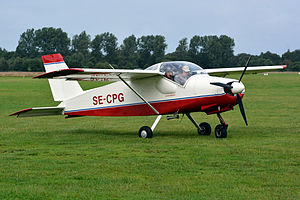Malmö MFI-9 Junior
| MFI-9 Junior | |
|---|---|

| |
| A Malmö MFI-9, (SE-CPG), at Uetersen Airport, Germany | |
| Role | Primary trainer
|
| Manufacturer | Malmö Flygindustri |
| Designer | Björn Andreasson |
| Built by | Bölkow (under licence) |
| First flight | 10 October 1958 |
| Introduction | 9 August 1962 |
| Variants | Saab Safari |
The Malmö Flygindustri MFI-9 Junior was a light aircraft produced in Sweden in the 1960s. The aircraft was also produced under licence in West Germany as the Bölkow Bo 208.
Development
The BA-7 was designed by
In 1960 Andreasson returned to Sweden and started working at
The MFI-9 uses a tricycle undercarriage.
Between 1963 and 1971, 210 Bölkow Bo 208s were built under licence by Bölkow Apparatebau GmbH in Laupheim, Germany. Many examples survive in private hands and are most commonly found in Germany, the United Kingdom and Scandinavia. A limited number of airworthy examples can be found in both the United States and New Zealand.
The most widely produced variant of the Bo 208 is the Bo 208C, which used a Continental O-200-A flat-four-cylinder air-cooled piston engine giving 75 kW (100 HP). A number of O-200 engines installed on Juniors were licence-built by Rolls-Royce in England.

MiniCOINs
One variant of the MFI-9 which gained widespread fame was the MiniCOIN (an acronym for "Miniature Counter-Insurgency"), a modification of the MFI-9B military trainer variant of the MFI-9, adapted to carry weapons.
The name and concept originated with
A number of MFI-9Bs had been constructed in hopes of a sale to the Swedish Air Force, but when the sale fell through, the aircraft became available at a low price. So in May 1969, von Rosen formed a squadron of five MiniCOINs to fight in the Nigerian Civil War (1967–1970) on the side of the Biafrans in support of their effort to create an independent state.[2]
Von Rosen had the planes painted in camouflage colours and fitted with rockets from
The pilots included
The MiniCOINs saw extensive service during most of the war, including the delivery of food aid drops. Garrison introduced a supply-dropping procedure learned in northern Canada. A bag of grain was enclosed in a larger bag before dropping; when the load hit the ground, the inner bag would rupture, while the outer bag contained the contents. Many lives were saved through air drops using this simple concept.
A total of 18 were supplied.[5]
Variants
- MFI-9 – Two-seat primary trainer aircraft. 25 built.
- MFI-9B Trainer – Two-seat sports, primary trainer aircraft. 43 built.
- Biafra Baby – Five MFI-9Bs armed with six French SNEB 68 mm (2.68") unguided folding-fin rockets with armor-piercing warheads under each wing.
- MFI-9B Mili-Trainer – Two-seat primary trainer, light-attack aircraft. Two prototypes built. Ten aircraft leased by the Swedish Air Force 1966–68 for evaluation as a primary trainer only.
Military operators
 Biafra
Biafra
- Used by the Biafran War.
- Ten MFI-9B Mili-Trainers evaluated by the Swedish Air Force.
Specifications (MFI-9B)

Data from Jane's All The World's Aircraft 1965–66[6]
General characteristics
- Crew: Two
- Length: 5.85 m (19 ft 2 in)
- Wingspan: 7.43 m (24 ft 5 in)
- Height: 2.00 m (6 ft 7 in)
- Wing area: 8.70 m2 (93.6 sq ft)
- Aspect ratio: 6:1
- Airfoil: NACA 23008.5 (mod.)
- Empty weight: 340 kg (750 lb)
- Max takeoff weight: 575 kg (1,268 lb)
- Fuel capacity: 80 L (21 US gal; 18 imp gal)
- Powerplant: 1 × flat-fourengine, 75 kW (100 hp)
Performance
- Maximum speed: 236 km/h (147 mph, 127 kn) at sea level
- Cruise speed: 215 km/h (134 mph, 116 kn) (econ. cruise)
- Stall speed: 80 km/h (50 mph, 43 kn)
- Never exceed speed: 305 km/h (190 mph, 165 kn)
- Range: 800 km (500 mi, 430 nmi) (with maximum payload)
- Service ceiling: 4,500 m (14,800 ft)
- Rate of climb: 4.3 m/s (850 ft/min)
See also
Aircraft of comparable role, configuration, and era
References
Notes
- ^ "The BA-7". Sport Aviation. July 1959.
- ^ a b Jowett 2016, p. 18.
- ^ "[Biafra] Biafra: Killer Cessnas and Crazy Swedes". Nigeriavillagesquare.com. Retrieved 2014-07-12.
- Time Magazine25 October 1968
- ^ Jowett 2016, p. 19.
- ^ Taylor 1965, p. 121
Bibliography
- Jowett, Philip (2016). Modern African Wars (5): The Nigerian-Biafran War 1967-70. Oxford: ISBN 978-1472816092.
- Simpson, R. W. (1995). Airlife's General Aviation. Shrewsbury: Airlife Publishing. p. 85.
- Taylor, John W. R. (1965). Jane's All The World's Aircraft 1965–66. London: Samson Low, Marston.
- Taylor, Michael J. H. (1989). Jane's Encyclopedia of Aviation. London: Studio Editions. p. 192.
- 'Fleas versus Falcons over Biafra' (retrieved February 23, 2008)
